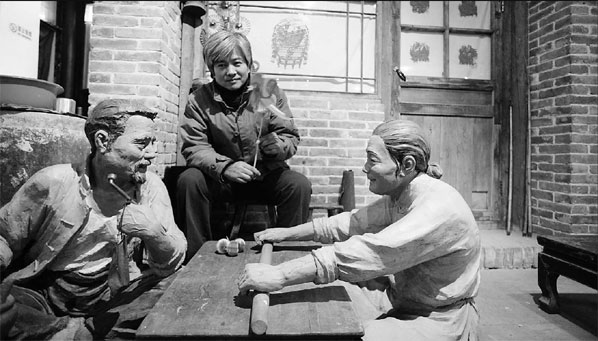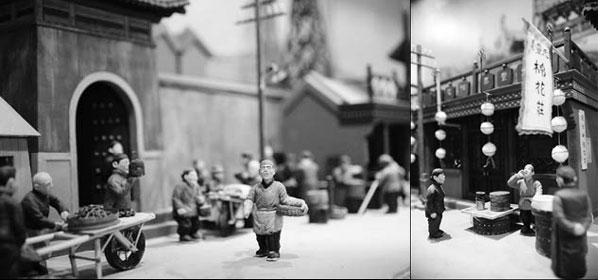Small slice of history
|
Zhang Yujun sits in his Hutong Zhang Beijing Folk Art Museum. |
Zhang Yujun, 47, calls himself "a diehard fan of the hutong culture in Beijing". Over the past decade, the Beijing native has invested almost all of his money, energy and wisdom into building a huge collection of toys, old articles, handicrafts, paintings and old photos of Beijing.
However, what makes this descendant of a Qing Dynasty Manchu family famous is his collection of handmade, vivid miniatures of the streets and hutong alleys in the 1920s Beijing.
People call him "Hutong Zhang" for his efforts to offer a window into old Beijing's traditional customs and local cultures at his Hutong Zhang Beijing Folk Art Museum.
The museum is located opposite the National Memorial of Chinese People's War Against Japanese Aggression near the Marco Polo Bridge (Lugou Bridge) in Wanping town of Fengtai district.
Stepping into the two-storied, old style building with upturned eaves, colorful patterns and glazed tiles, visitors will find myriad old toys, handicrafts, vintage photos and posters.
Visitors can also savor tea, traditional snacks, enjoy Peking Opera, join in shadow puppet shows, craft making and traditional games.
But the most eye-catching exhibits are rows of miniature siheyuan courtyards, buildings and old streets that measure about 100 m long.
The miniature Beijing scenes include stores selling fresh and dried fruits, candies, snacks, toys, hats, leather goods and curiosities.
They also feature temples, market places, guild houses, teahouses, monasteries, opera houses, courtyards, electrical cable posts, posters on the walls, and all manner of utensils.
On the street and in the hutong are vividly portrayed clay figurines - casual visitors, customers, vendors and shop owners. There are also rickshaws, carts selling coal and water, and limousines of traveling salesmen. All these exhibits evoke strong nostalgia for traditional Beijing life.
"The hutong culture, a supplement to the royal culture exemplified by such places as the Forbidden City, the Temple of Heaven, and the Summer Palace, is an important part of Beijing's history and its cultural identity," Zhang says.
Zhang admits he cherishes his memories of bygone years in the hutong and siheyuan courtyards in downtown Chongwen district.
Tormented by the fact that many of Beijing's hutong have given way to re-development for commercial use, Zhang finally decided to quit his job as a graphic designer at a State-run post office in 1997 and became a folk artist.
He first opened a crafts shop on Wangfujing Street, selling old-style Beijing toys he created and then clay figures representing old Beijing culture, from courtyard houses to Manchu maidens, Peking Opera masks to scenes from life in the capital many years ago.
In late 1997, Zhang got the idea of assembling his collections and creations into miniature streets "to give a clearer picture of how Old Beijing looked like and how Old Beijingers lived," Zhang says.
Most of the exhibited figurines, buildings and streets scenes, and the almost forgotten customs behind them have their origins, Zhang says.
Before starting out to design and create the miniatures, he collected much information about old Beijing from books, photos, old films, field research and descriptions from the older generation.
His efforts eventually paid off after 10 years of strenuous work. Zhang and his partners invested at least 1 million yuan ($139,000) to open the museum last May. So far, the museum has attracted more than 50,000 Chinese and foreign visitors, according to Zhang.
Although it will be a long time until the business breaks even, Zhang is confident about his new career.
Modernization seems an unstoppable trend. But the cultural roots of Beijing should not be simply ignored, hastily dismantled and buried deep by modern buildings, Zhang says.
Zhang cited the hutong and siheyuan courtyards in Xicheng district as prime examples, "In 1949, there were reportedly 820 hutong in this district; now, only about half still exist under poor conditions.
"I would never imagine there would be a day when people have to queue up for tickets to visit a tiny area of preserved hutong and courtyards."
There should be a balance between the modern and the traditional in this city of long history and rich cultures, Zhang says.
"I believe I am not the only person who loves the traditional culture of Beijing and wants to do something to keep it long alive," he says.
|
Miniaturized old Beijing streets are exhibited in the museum. Photos by Lu Zhongqiu |
(China Daily 03/25/2008 page20)
















